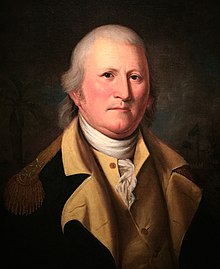William Moultrie
| William Moultrie | |
|---|---|

Portrait of William Moultrie by Charles Willson Peale, 1782
|
|
| 35th Governor of South Carolina | |
|
In office February 11, 1785 – February 20, 1787 |
|
| Lieutenant | Charles Drayton |
| Preceded by | Benjamin Guerard |
| Succeeded by | Thomas Pinckney |
|
In office December 5, 1792 – December 17, 1794 |
|
| Lieutenant | James Ladson |
| Preceded by | Charles Pinckney |
| Succeeded by | Arnoldus Vanderhorst |
| 10th Lieutenant Governor of South Carolina | |
|
In office February 16, 1784 – February 11, 1785 |
|
| Governor | Benjamin Guerard |
| Preceded by | Richard Beresford |
| Succeeded by | Charles Drayton |
| Personal details | |
| Born |
November 23, 1730 Charlestown, Province of South Carolina, British America |
| Died | September 27, 1805 (aged 74) Charleston, South Carolina, U.S. |
| Religion | Anglican/Episcopal |
| Military service | |
| Allegiance |
|
| Service/branch |
|
| Years of service | 1761 1775 – 1783 |
| Rank | Major General |
| Unit | 2nd South Carolina Regiment |
| Battles/wars |
Anglo-Cherokee War American Revolutionary War *Battle of Sullivan's Island *Siege of Savannah *Siege of Charleston |
William Moultrie (/ˈmuːltriː/; November 23, 1730 – September 27, 1805) was a planter and politician who became a general from South Carolina in the American Revolutionary War. As colonel leading a state militia, in 1776 he prevented the British from taking Charleston, and Fort Moultrie was named in his honor.
After independence, he advanced as a politician; Moultrie was elected by the legislature twice over a period of years as Governor of South Carolina (1785–87, 1792–94), serving two terms. (The state constitution kept power in the hands of the legislature and prohibited governors' serving two terms in succession.)
Moultrie was born in Charlestown in the Province of South Carolina. His parents were Dr. John and Lucretia (Cooper) Moultrie, and he was educated as a planter.
He fought in the Anglo-Cherokee War (1761). He was elected to the colonial assembly representing St. Helena Parish before the advent of the American Revolution.
In 1775 Moultrie was commissioned colonel of the 2nd South Carolina Regiment, in the state militia. In December of that year he led a raid on an encampment of runaway slaves on Sullivan's Island, killing 50 and capturing the rest. The island served as the main landing point for African slaves imported to Charleston; an estimated 40% of the total estimated 400,000 Africans brought to the United States as slaves landed here.
In 1776 Moultrie's defense of a small fort on Sullivan's Island (later named Fort Moultrie in his honor) prevented Sir Henry Clinton and Sir Peter Parker from taking Charleston. The Continental Congress passed a resolution thanking Moultrie. He was promoted to brigadier general and his regiment was taken into the Continental Army.
...
Wikipedia
